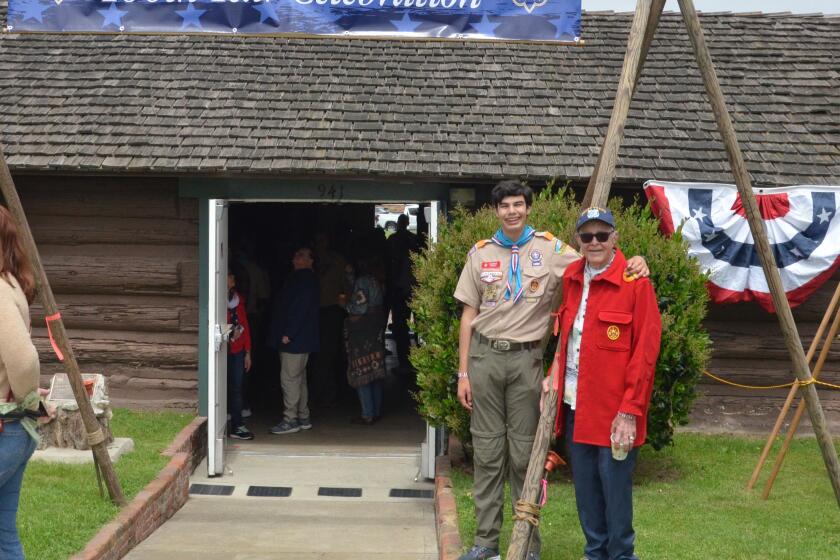‘Face of the museum’ steps down
On an afternoon last week, Gary Sahagen played a role that he had watched many others play during his decade at the International Surfing Museum.
The role of visitor.
Sahagen, who joined the museum as a trustee in 2001, stepped down in January from his post as director-at-large. Before agreeing to meet at his former grounds for an interview and photo shoot, he admitted that walking through the front door might be bittersweet.
But as he led an impromptu tour around the shelves and displays, Sahagen seemed like the man in charge, even if he wasn’t any longer.
In the small confines of the one-story museum at 411 Olive Ave., he couldn’t go more than a few steps without telling a yarn — about the camera in the glass case that filmed the movie “The Endless Summer,” about the autographed Dick Dale guitar, about the primitive wooden surfboard hung a few inches below the ceiling.
Sahagen, a veteran longboarder and chief executive of a Huntington Beach-based family business, never made a living off running the surfing museum. That’s hardly apparent, though, from listening to him talk about the institution that he helped shape and promote for more than 10 years.
“Representing the museum and Surf City, it’s just an honor,” said Sahagen, who served as executive director and other titles over the years. “Sometimes I pinch myself and can’t believe I get to do this stuff.”
Early this year, Cindy Cross, a fellow member of the museum’s board of directors, took over as director-at-large. According to board Chairman Brett Barnes, Cross inherited Sahagen’s job title, but no one has stepped up to do the day-to-day tasks — such as leading tours and answering visitors’ questions — that he did, among other things, for 40 or more hours a week.
Sahagen said he decided to step down after the museum began focusing more on retail; a year ago, the facility underwent a remodel and added space for merchandise. He preferred to run the museum as a tourist spot, rather than as a business, which ultimately led to his resignation.
Still, Sahagen and Barnes both said the split was amiable. As he prepared to step down, the director-at-large worked with other staff to make the transition smooth.
“He was the face of the museum,” Barnes said. “He represented the museum well. We’re happy for all the work he’s done.”
With the museum behind him, Sahagen plans to devote more time to his other surfing passion: the Huntington Beach Longboard Crew, a nonprofit club that competes up and down the coast and raises funds for charity.
The club, which formed in 1985, played a role in the museum’s birth, attending early meetings and helping to raise money. The museum opened its doors in 1987 and, a few years later, hosted an exhibit on Sahagen’s group. One of the items on display was the club’s permanent trophy, which went missing after the exhibit closed.
When Sahagen joined as a trustee, he volunteered to organize the museum’s archives. During that experience, and stumbled upon the trophy, which had been buried in a plastic bag.
Over the next decade, Sahagen created some of the museum’s lasting installations, including a collection of jars of sand imported from surfing beaches around the world. Earlier this year, he helped former Angels’ announcer Rex Hudler set up the charity event Surf’s Up for Down Syndrome.
“That was kind of like my parting, ‘see ya,’” Sahagen said.
Some of the people Sahagen collaborated with over the years are inclined to give him more than a “see ya” as he departs.
Steve Bone, the president and chief executive of the Huntington Beach Marketing and Visitors Bureau, credited Sahagen with not only enhancing the surfing museum but also spreading the city’s global reputation.
“A compliment is always made when one copies what the original has done, and we’ve seen, during his administration, surfing museums pop up in Hawaii and in Oceanside and other jurisdictions,” he said. “It’s both a wonderful historical, almost a sociological, museum, as much it is just a pure visitor draw.”
Sahagen got a fond farewell from another surf culture icon: Dean Torrence, half of the 1960s pop duo Jan and Dean, whose song “Surf City” gave the city its official nickname. In the past, Torrence worked with Sahagen on an exhibit honoring Jan and Dean and other surf-music groups.
“Gary will be missed,” Torrence said. “And hopefully, whatever happens, he could be a part of the next phase of the surfing museum. Hopefully, he will be. He’ll certainly have my vote.”
Twitter: @MichaelMillerHB
All the latest on Orange County from Orange County.
Get our free TimesOC newsletter.
You may occasionally receive promotional content from the Daily Pilot.



